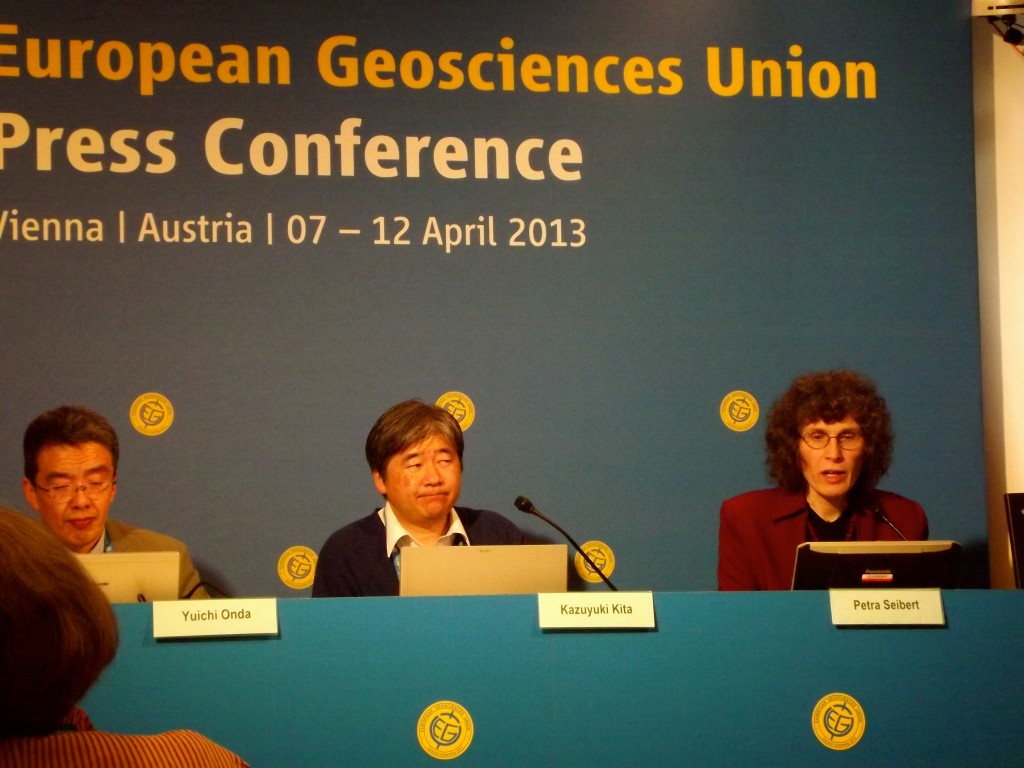Here is an insight into what the GfGD team got up to on day two of #EGU2013!
c
Geoethics and Natural Hazards
This morning saw sessions on ‘Geoethics and Natural Hazards’ that contained plenty of enthusiastic discussion on the L’Aquila case. Joel Gill, GfGD’s Director was there bright and early and covered the session on Twitter:
Keep up with all of the GfGD team at #EGU2013 in real time by following us on twitter (@GillJoel, @RosalieTostevin, @Faithatron, @Geo_dev)
“Ruth described the importance of good communication, project management, and effective leadership. GfGD are working to give students opportunity to develop these essential skills at the outset of their careers. As Ruth described, this is not devaluing technical science, but better preparing geoscientists to serve society.”
Water, Climate and Health
This session (HS7.3) ran all day, and the talks really highlighted the range of ways that access to clean water can impact peoples lives. This session also emphasized the many ways that climate change exacerbates or causes a wide range of problems. Changes in humidity, temperature, and soil processes can all influence disease outbreaks and impact food safety and air quality. Look out for more on this field later in the week as there is a press conference scheduled for tomorrow, where the latest results from this research field will be revealed…
A few examples of the link between climate and human health:
- Enrico Bertuzzo showed a convincing link between rainfall and cholera outbreaks in Haiti. If we can predict rainfall patterns accurately, then maybe we can anticipate, and prepare for, the spread of disease.
- Dengue fever is one of the most serious vector-borne diseases, and there is currently no available vaccine. The disease is transmitted by mosquitos and exists in over one hundred different countries, leading to as many as 25,000 deaths each year. Yuan-Chien Lin showed that the minimum weekly temperature and the maximum daily rainfall are the two best variables for predicting dengue fever outbreaks.
- James Tamerius spoke about the link between influenza outbreaks and humidity. Temperate epidemics occur when specific humidity is at its lowest, but in the tropics we see epidemics as specific humidity is increasing.
Urban Heat Waves
Nigel Tapper described the growing problem of heat waves in urban environments. After the recent cold snap in the UK, I think a lot of people would welcome the idea of a heat wave, but extreme heat waves can lead to the death of vulnerable groups of people, such as the elderly. Extreme weather is becoming more common as a result of anthropogenic warming.
Heat waves pose a particular problem in urban heat islands, where temperatures are already elevated relative to the surrounding countryside. We have seen intense urbanisation over the last century, with over half of the world’s growing population now living in urban areas. The urban heat island problem is set to worsen for two reasons: there is a push to increase the density of buildings in cities, and our ageing populations are particularly vulnerable to high temperatures. The heat island effect is something we need to consider carefully as we expand cities outwards and upwards.
Neville Nicholls modelled the relationship between rising temperatures and expected mortality in people over the age of 64. He found a large step increase (17%) in mortality over a small temperature threshold (28-30 degrees), suggesting that even modest amounts of heat mitigation can have a significant impact. His data comes from Australia, where concerns about climate change are heightened following a decade of drought. In 2009, during the ‘black summer’, there were a lot of heat related deaths as well as fires that took many lives.
Read more about Tapper’s work on his website dedicated to “mapping vulnerability”.
c
Nuclear Disasters
There was a press conference today about the consequences of severe nuclear accidents. We have seen major nuclear accidents in Europe (Chernobyl) and Japan (Fukushima). We cannot rule out another nuclear disaster in the future, and it is important that we learn from previous disasters. It is fitting that this press conference was held today, as a magnitude 6.3 earthquake in the Zagros mountains, SW Iran, raised fears about damage to a nearby nuclear plant.
The effects of a nuclear disaster are wide ranging as nuclear fallout migrates through the environment, penetrating soils and infiltrating rivers. Failures in both communication and monitoring during the Fukushima disaster have prompted policy rethinks worldwide.
Petra Seibert, a professor from the University of Vienna, described the emergency response in the immediate aftermath of the Fukushima disaster as ‘unsatisfactory’. What is particularly worrying, is that she doesn’t think this is a problem confined to Japan; the rest of the world is not adequately prepared to effectively deal with another nuclear disaster either.
In most countries that use nuclear power, the models used to understand risk are too simple and the emergency evacuation zones are too small. People living outside of the designated evacuation zone are not supplied with the resources, such as iodine tablets, that they would need in the immediate aftermath of a nuclear meltdown. This leaves large areas of the world vulnerable and unprepared for the consequences of another nuclear disaster.
c
That’s all for today. We’ll be back at the EGU General Assembly tomorrow covering more sessions and press conferences. If there is anything you would like to see covered on our blog, let us know using the comments box at the bottom of the article!



